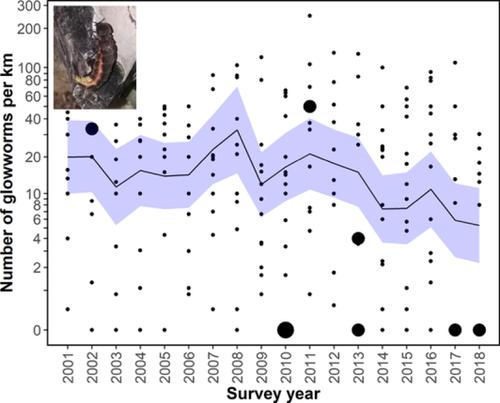当前位置:
X-MOL 学术
›
Insect Conserv. Divers.
›
论文详情
Our official English website, www.x-mol.net, welcomes your
feedback! (Note: you will need to create a separate account there.)
Glowing, glowing, gone? Monitoring long‐term trends in glow‐worm numbers in south‐east England
Insect Conservation and Diversity ( IF 3.2 ) Pub Date : 2020-03-04 , DOI: 10.1111/icad.12407 Tim Gardiner 1 , Raphael K. Didham 2, 3
中文翻译:

发光,发光,走了吗?监测英格兰东南部萤火虫数量的长期趋势
更新日期:2020-03-04
Insect Conservation and Diversity ( IF 3.2 ) Pub Date : 2020-03-04 , DOI: 10.1111/icad.12407 Tim Gardiner 1 , Raphael K. Didham 2, 3
Affiliation

|
- The glow‐worm Lampyris noctiluca (Linnaeus, 1767) (Coleoptera: Lampyridae) is thought to be declining in the United Kingdom. Yet, much of the evidence for this is anecdotal, with a shortage of standardised long‐term data to investigate temporal changes in abundance.
- We present an 18‐year time series of standardised transect surveys for glowing adult females at 19 sites within south‐east England (Essex) from 2001 to 2018.
- We used generalised additive mixed models (GAMMs) to control for varying sampling effort, temporal autocorrelation, non‐stationarity of seasonal phenology and non‐linearity of temporal trajectories across sites.
- We found a significant long‐term reduction in counts of glowing female glow‐worms, after accounting for a significant shift in seasonal phenology across years, and a negative effect of warmer climatic conditions on glow‐worm abundance. Average glowing counts in south‐east England declined by ca. −3.5% per annum from 2001 to 2018, and this result held true even after a range of sensitivity tests to account for potential methodological artefacts in citizen science data collection.
- Temporal trajectories in abundance were strikingly out of phase across the 19 sites, suggesting that local‐scale factors in addition to climate are driving greater reduction in numbers at some sites than others.
- These standardised surveys present the first quantitative evidence that numbers of glow‐worms could well be declining in the United Kingdom. There is a clear signal of climate warming and drying effects on glow‐worm numbers, but a substantially greater proportion of variation in glowing female counts is explained by local‐scale site factors, such as unmanaged scrub encroachment. Conservation strategies that can mitigate local population losses could be an essential buffer against climate‐driven declines in south‐east England.
中文翻译:

发光,发光,走了吗?监测英格兰东南部萤火虫数量的长期趋势
- 在萤火虫Lampyris夜光虫(林奈,1767)(鞘翅目:萤科)被认为是英国在下降。然而,很多证据是轶事,缺乏标准化的长期数据来调查丰度的时间变化。
- 我们为英国东南部(Essex)的19个站点提供了18年的标准化断面调查时间序列,从2001年至2018年。
- 我们使用广义加性混合模型(GAMM)来控制不同站点的采样工作,时间自相关,季节性物候的非平稳性和时间轨迹的非线性。
- 在考虑了多年以来季节性物候的重大变化以及气候变暖对萤火虫数量的负面影响之后,我们发现发光的雌性萤火虫的数量已长期大量减少。英格兰东南部的平均发光数量下降了约20%。从2001年到2018年,年均−3.5%,即使经过一系列敏感性测试,以考虑公民科学数据收集中的潜在方法学伪像,这一结果仍然成立。
- 在这19个地点中,大量的时间轨迹明显不同相,这表明,除了气候以外,当地尺度的因素还导致一些地点的数量减少幅度更大。
- 这些标准化的调查提供了第一个定量证据,表明英国的萤火虫数量很可能正在下降。明显有气候变暖和干燥对萤火虫数量的影响的信号,但是发光的雌性数量变化的比例要大得多,这是由局部规模的地点因素解释的,例如不受管理的灌木丛侵害。可以减轻当地人口流失的保护策略可能是应对英格兰东南部气候驱动的衰退的重要缓冲。











































 京公网安备 11010802027423号
京公网安备 11010802027423号